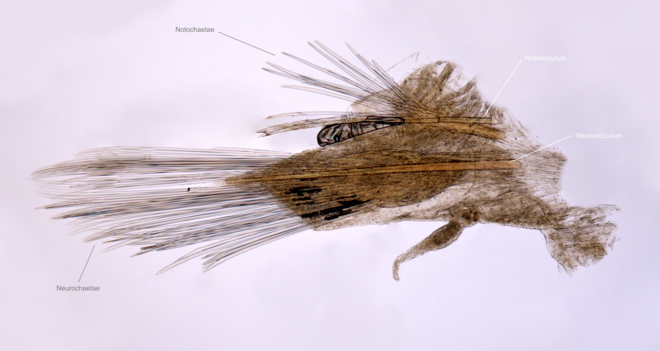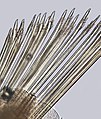Chaeta
A chaeta or cheta (from Greek χαίτη “crest, mane, flowing hair"; plural: chaetae) is a chitinous bristle or seta found in annelid worms, (although the term is also frequently used to describe similar structures in other invertebrates such as arthropods). Polychaete annelids, ('polychaeta' literally meaning "many bristles") are named for their chaetae. In Polychaeta, chaetae are found as bundles on the parapodia, paired appendages on the side of the body[1]. The chaetae are epidermal extracellular structures, and clearly visible in most polychaetes. They are probably the best studied structures in these animals.[2]

Use in taxonomy and identification
The ultrastructure of chaetae is fundamentally similar for all taxa but there is vast diversity in chaetal morphology [3]. Moreover, chaetae bear precise characters for determination of species and taxonomic assessment. The shape, absolute and relative size, number, position, ornamentation and type are important taxonomic characters and specific types are often associated with families or genera[4]. They are sometimes also species-specific and in some cases can be used to differentiate otherwise identical-looking species[2].
Types of chaetae

Both lobes of the parapodium, the notopodium and neuropodium can bear chaetae. Chaetae on the notopodium are called notochaetae and those on the neuropodium are called neurochaetae. Thick, internal chaetae that provide support for well-developed notopodia or parapodia are called acicula.
A wide range of chaetal shapes and arrangements exists:[5][1][3][4]
Basic forms are capillaries and spines. Capillaries are the most common form of chaetae and are very thin and tapering. Spines are also common but are thicker and stouter than capillaries and may be curved or straight and can be distally dentate (e.g. unidentate or bidentate).
Furcate (also called comb, forked or brush) cheatae are similar to capillaries for most of their length but expand distally into a flattened comb- or fork-like tip.
Hooks are stout cheatae that curve distally and may be dentate or strongly curved (falcate). These chaetae may also be capped with a translucent hyaline hood.
Compound chaetae possess a joint or hinge toward the distal end that allows a distal blade or appendage to articulate around it.
Uncini are highly modified chaetae in which the shaft is reduced (or virtually absent) and the tip is broadened to create short, stout structures. These are often present in sedentary taxa.
 unidentate neurochaetae from a Lepidonotus sp. specimen from Museums Victoria
unidentate neurochaetae from a Lepidonotus sp. specimen from Museums Victoria bidentate neurochaetae from a Lepidonotus sp. specimen from Museums Victoria
bidentate neurochaetae from a Lepidonotus sp. specimen from Museums Victoria
See also
References
- Hutchings, P. A.; Fauchald, K. (2000). Polychaetes and Allies: the Southern Synthesis - Class Polychaeata: Definition and General Description. Melbourne: CSIRO Publishing. pp. 1–3.
- Hausen, H. (2005). "Chaetae and chaetogenesis in polychaetes (Annelida)". Hydrobiologia. 535-536: 37–52. doi:10.1007/s10750-004-1836-8.
- Rouse, Greg; Pleijel, Frederick (2001). Polychaetes. Oxford: Oxford University Press. ISBN 0198506082.
- Blake, J. A.; Hilbig, B.; Scott, P. H. (1997). Taxonomic atlas of the benthic fauna of the Santa Maria Basin and Western Santa Barbara Channel. Volume 4 - The Annelida part 1. Santa Barbara: Santa Barbara Museum of Natural History. ISBN 9780936494258.
- Merz, R. A.; Woodin, S. A. (2006). "Polychaete chaetae: Function, fossils, and phylogeny". Integrative and Comparative Biology. 46 (4): 481–496. doi:10.1093/icb/icj057. PMID 21672760.